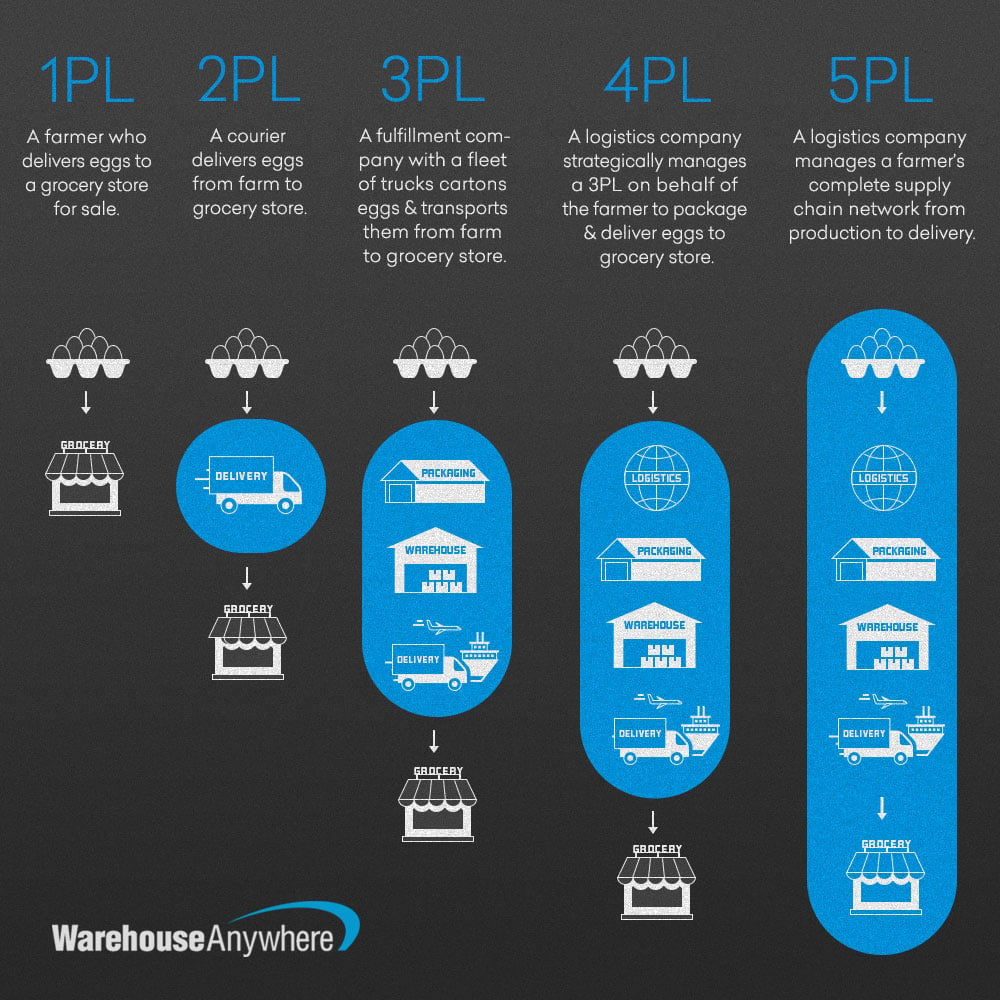.jpg?width=804&name=Blog%20Cover%20(5).jpg)
We're unpacking the often confused (and even debated) “PL” terminology. What is a 3PL, how is it different to a 4PL, and which one is right for your business?
logistics Jargon: Know your PL terminology
Supply Chain and Logistics terminology can seemingly not keep up with the rapid evolution of the industry. For years we have become accustomed to organisations adopting 3-or-4PL business models, but of late abbreviations such as 5, 6 and even 7PL beginning to become part of the logistics lexicon, but what exactly to do these terms mean?
What is a first-party logistics provider (1PL)?
A first-party logistics provider refers very simply to any organisation that needs to move product from point A to point B. In this type of model, both the sender and receiver of goods is called a 1PL, and the action of moving products is carried out by their own internal departments with no service provider used for transportation.
What is a second-party logistics provider (2PL)?
Second-party logistics refers to a business model in which an organisation appoints a subcontractor to perform defined logistical activities, for example, a single transport route, or warehouse management. All other traditional supply chain activities such as planning or follow-ups remain the responsibility of the shipper, and this model is often ad-hoc and highly cost sensitive. A second party logistics provider will own the means of transportation – such as shipping or airfreight logistics.
What is a third-party logistics provider (3PL)?
A Third Party Logistics Provider is the first logistics model in which the outsourcing of a part of the supply chain occurs. 3PLs offer integrated supply chain solutions such as:
- Transportation
- Warehousing
- Cross-docking
- Inventory management
- Packaging
- Freight forwarding
An organisation will outsource a part of the supply chain, which can incorporate multiple logistical activities.
The provider will become the point of contact for the organisation and manage the activities required to successful service the outsourced requirement. The 3PL provider may own, or subcontract the logistical activities required by the organisation but is responsible for the entire management of such. These relationships are often more long-term; however, the client will retain expertise necessary to monitor and correct the logistics activities handed to the outsourced partner.
What is a fourth-party logistics model (4PL)?
Fourth Party Logistics refers to a model where a non-asset based supply chain integrator takes full responsibility for the management of end-to-end supply chain on behalf of a client. The model requires the 4PL to plan, resource and build comprehensive solutions on behalf of the contracting client. 4PL encompasses all of the services of 3PL, as well as:
- Logistics strategy and analytics
- Freight sourcing strategies
- Network analysis, design and management
- Consultancy and business planning (including change management)
- Project management
- Inventory planning and management
- Inbound, outbound and reverse logistics
This model will often see the 4PL provider contracting various 3PL providers on behalf of the client to deliver the required logistical solutions. This type of model requires intense participation by the 4PL provider in the clients business, and the model is based on collaboration and grounded more in long-term value creation than short-term cost focus.
A major drive for strategic sourcing is in developing and sustaining buyer-supplier relationships to jointly reduce cost and create sustainable value for all parties, particularly the customer.
What is a fifth-party logistics provider (5PL)?
A newer term in Supply Chain, a Fifth Party Logistics Provider has arisen from the switch of thinking from supply chains to supply networks. 5PL providers will manage and aggregate the needs of 3PL providers to extract maximum value from airlines and shippers thanks to bulk volume. A 5PL model has an intense focus on e-commerce and the utilisation of appropriate technologies to build the most efficient supply network possible.
Visual break down of each of the different logistics solutions
The following infographic gives a simple illustration of what each of the PL solutions do for your business.

Image source: Warehouse Anywhere
What is a sixth-party logistics model (6PL)?
Sixth Party Logistics moves into the realm Artificial Intelligence and is referred to as an AI Driven Supply Chain. While not much is known about the functioning of such Supply Chains yet, the definition implies the use of AI in the aggregation and analysis of large amounts of data to action, improve and manage supply chain activities throughout the entire process. For example, AI would learn ordering patterns and instruct upstream activities to be triggered proactively, or flag orders as unusual if products are ordered to close together or in illogical patterns.
What is a 7PL?
The term 7PL refers merely to a 4PL provider that owns 3PL activities instead of only managing the providers, as with a more traditional 4PL model. Such models counter concerns that a 4PL is simply a middleman by combining supply chain expertise with asset ownership to undertake bespoke solutions, inclusive of all activities under one ownership umbrella.
As the supply chain industry continues to evolve, we are likely to see more and more “PL” terms emerging with 8PL, 9PL and even 10PL already being mentioned in some circles.
While the terminology and ever-evolving definition of a successful supply chain can be confusing, perhaps it is important to remain focused on the basics. Those of right time, right place and right cost. In order to remained focused on the core of a supply chain it is therefore important to engage a partner that represents a business-fit to unlock maximum value – regardless of the so-called “PL” model that this represents.
Not sure which model is right for your business? Get in touch with us and let's explore your needs together




